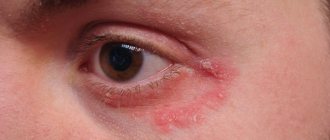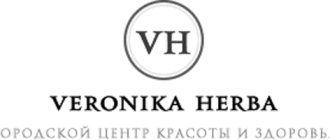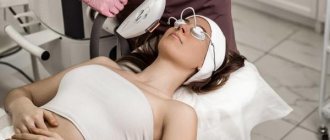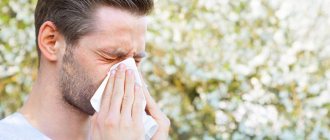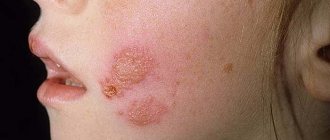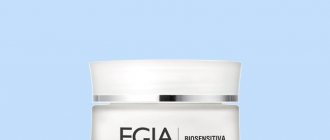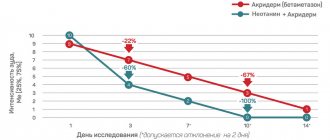Dermatovenerologist
Khasanova
Alina Rashidovna
9 years experience
Make an appointment
A common purulent-inflammatory skin disease of an infectious type, the causative agent of which is bacteria of the genus streptococci, is called streptoderma. This infection accounts for up to 40% of dermatological diseases characterized by the presence of lesions associated with the formation of pustules. In about a third of cases, the disease is severe and leads to temporary disability for the patient.
Nature and causes of skin lesions
The disease primarily affects smooth areas and skin folds, with lesions prone to peripheral growth. Typically, the disease does not affect the sebaceous and sweat glands, hair follicles. The localization of lesions can be on any part of the body - on the skin of the extremities, face and scalp, torso, groin or gluteal fold, etc.
The infection affects people of all ages, and in adults it occurs most often among workers in the construction, transport, metallurgy and mining industries, for whom it is often considered an occupational disease. Streptococci in an inactive state are present in the bodies of the vast majority of people, but the most common causes of streptoderma in adults are:
- reduced immunity combined with massive transmission of infection from a sick person;
- minor skin injuries that contribute to disruption of its barrier function;
- dysfunction of the central nervous system due to stress or fatigue, leading to decreased immunity, deterioration of tissue trophism and blood circulation;
- the presence of a chronic endocrine disease, which increases the risk of developing purulent-inflammatory processes;
- taking certain medications that reduce the body's resistance to streptococcus;
- disturbances in the composition of the intestinal microflora due to poor nutrition, leading to inhibition of the function of intestinal immune cells;
- failure to comply with personal hygiene rules, which creates favorable conditions for the growth of bacteria.
In children, streptoderma most often develops in the preschool period and accounts for up to 60% of pustular skin lesions. Bacteria are usually transmitted through household means; the development of infection is facilitated by the presence of small wounds, abrasions or scratches, and insect bites.
How to treat streptoderma
To increase the effectiveness of streptoderma treatment, the patient should adhere to the following recommendations:
- stay at home until recovery, do not contact other people;
- avoid contact with common household objects;
- change bed linen every two days (wash used linen at high temperature and iron after washing);
- do not take a shower or bath, so as not to spread the infection throughout the body;
- wear underwear made from natural fabrics and change it every day.
How quickly a patient recovers depends on his age, individual characteristics of the body, the severity of the disease and the presence of concomitant pathologies. Today, thanks to high-quality antibacterial drugs, the effectiveness of treatment measures has increased significantly - it is possible to get rid of the disease in an average of 7-10 days.
For streptoderma, the patient is prescribed:
- Antiseptics (fucorcide, potassium permanganate, hydrogen peroxide 1%, methylene blue 2%, brilliant green 2%, salicylic alcohol 2%). They are applied not only to the hearth, but also around it. Hard crusts can be pre-treated with Vaseline, and then carefully removed and the resulting wound washed with an antiseptic.
- Antibiotics. For local treatment, ointments can be used: Triderm, Erythromycin, Gentamicin, Retapamulin, Baneocin, Bactroban, etc. They relieve inflammation and destroy pathogens.
For widespread streptoderma, medications are administered intramuscularly or intravenously. Since streptococcus is most sensitive to penicillins, dermatologists recommend penicillin antibiotics (Amoxicillin, Clarithromycin, Ciprofloxacin, Flemoxin Solutab, Erythromycin, Augmentin). The duration of antibacterial therapy is from 7 to 14 days.
To quickly cure streptoderma in children and adults, taking vitamin and mineral complexes that help strengthen the immune system is indicated. Among the effective immunomodulatory drugs: Neovir, Pyrogenal and Levamisole. They have a pronounced anti-inflammatory and desensitizing effect, increase the body's resistance to infectious agents.
Manifestations of the disease
Streptococci enter the body through minor damage to the skin and mucous membranes and begin to actively multiply, releasing toxins and protective factors from immune cells into the surrounding tissues. 7-10 days after infection, the patient’s body develops a general reaction to the infection in the form of increased body temperature, malaise, muscle pain and headaches. But the main symptom of streptoderma is the appearance of characteristic rashes on the skin, accompanied by itching. The appearance and localization of skin manifestations are determined by the current clinical variant of the disease.
- Streptococcal impetigo is small blisters with clear liquid, which then becomes cloudy and transforms into pus. After a few days, yellowish-red crusts with a loose structure appear in their place. The number of blisters increases, the spots of the affected skin increase in size, crusts are located in the center of each spot, and fresh blisters are located along the edge against the background of swollen skin.
- Zaeda is a slit-like erosion of the skin that forms in the corners of the mouth. It looks like a crack surrounded by flaking pieces of skin and yellow crusts. This is one of the most difficult forms of the disease to treat, since the affected area is additionally injured while eating or talking.
- Panaritium is a horseshoe-shaped inflammation around the nail plate of the finger. The skin acquires a pink-bluish tint, swells, peels off along the edge of the cuticle, and pus is released from under the nail fold when pressed.
- Diaper rash is a type of streptoderma, the symptoms of which most often appear in people with type 2 diabetes, obesity, hypercortisolism, or against the background of seborrheic dermatitis. The disease is localized mainly in the natural folds of the skin - between the buttocks, in the groin area, in the armpits, behind the ears, under the mammary glands, etc. Skin damage is promoted by intense sweating and maceration of the stratum corneum of the skin, a bright red erosive spot and cracks appear in the depths of the fold. The spot constantly gets wet, causing burning and itching.
- Acute diffuse streptoderma is localized mainly on the skin of the legs, around infected wounds, burns or fistulas. Affected areas with a weeping surface and yellow crusts border the injured area. The infection is accompanied by swelling of the extremities and hyperemia, and complications often develop in the form of inflammation of the lymph nodes.
- Lichen simplex appears mainly on the skin of the face in the form of a bright pink rash with clearly defined boundaries.
- Ecthyma is a severe form of the disease with penetration of the purulent process deep into the tissue. An ulcerative-necrotic formation forms at the site of the skin lesion, and after healing a scar remains.
If left untreated, the infectious inflammatory process spreads to other parts of the body.
Are you experiencing symptoms of streptoderma?
Only a doctor can accurately diagnose the disease. Don't delay your consultation - call
Folk remedies
We have prepared recipes for you with which you can prepare an effective ointment for streptoderma at home.
Eucalyptus ointment
Kills various microbes (staphylococci, dysentery bacillus), including streptococci, which have become the source of streptoderma.
Ingredients:
- Eucalyptus leaves - 2 tbsp. spoons
- Vegetable oil - 2 tbsp. spoons.
- Oak bark - 2 tbsp. spoons.
How to prepare: Pour boiled vegetable oil over crushed eucalyptus leaves. Leave the composition to infuse for 3 days. After this, strain it through a sieve and squeeze it out. Separately, prepare the oak bark. For this, 2 tbsp. Grind tablespoons of bark and place in the oven for 30 minutes.
Dry it as much as possible so that you can chop it later. Pour boiling water in a ratio of 1:1). Leave to infuse for 40 minutes.
Mix both compositions in equal proportions and stir until the consistency of the ointment.
How to use: Apply the ointment once a day to the affected areas for a week.
Result: The ointment effectively fights infection. After completing the course for 7 days, the skin is noticeably cleared, the infection that became the source of the disease dies.
Ointment of yarrow, nettle and sorrel
Ingredients:
- Yarrow flowers - 1 tbsp. spoons.
- Nettle - 3 tbsp. spoons.
- Sorrel - 3 tbsp. Spoons.
- Milk - 1 l.
- Honey - 4 tbsp. spoons.
How to prepare: Grind all ingredients to a powder. Pour the resulting mixture with milk and boil over low heat for 25 minutes. Add honey and boil for another 10 minutes.
How to use: Apply ointment to problem areas of the skin 2 times a day. Use 10 days.
Important! Ointments prepared at home have a short shelf life, no more than 2 days. It is advisable not to use the product after the expiration date.
Result: The ointment effectively fights the disease. After application, the effect can be observed immediately. On the second day, the rash dries up. The skin gradually clears and brightens.
Diagnostic methods
To diagnose streptoderma, the doctor does not limit himself to examination and history taking, since external signs of the disease can easily be confused with other skin infections. To obtain accurate data, the patient is prescribed:
- microscopic examination;
- bacterial culture is the most informative research method, which allows not only to detect the causative agent of infection, but also to establish its pathogenicity, and also to check how sensitive it is to antibiotics.
Both tests are prescribed only if the patient has not used antibiotics or other medications. The patient may need to consult an endocrinologist if he has diabetes or is suspected of having this disease.
Diagnosis of streptoderma
The basic criteria for diagnosing streptoderma in children and adults are the presence of a clinical picture characteristic of the disease and the presence of the patient in the affected area. To confirm a preliminary diagnosis, the following is carried out:
- bacteriological culture of scrapings;
- microscopic examination.
The doctor finds streptococci in the scraping material. However, if before the consultation the patient independently used antibacterial ointments, microscopy may not be informative. Then the dermatologist relies only on symptoms.
Streptoderma must be differentiated from:
- pityriasis versicolor;
- hives;
- atypical dermatitis;
- eczema;
- pyoderma.
Additional diagnostic methods for the disease include:
- general and biochemical blood tests;
- blood test for thyroid hormones;
- general urine analysis;
- blood test for Wasserman reaction;
- blood test for syphilis.
You can undergo a full diagnosis at any of the dermatological centers
.
Elimination of skin lesions
If the disease has not become severe, treatment of streptoderma is carried out on an outpatient basis. If there are severe symptoms - deep erosion and necrotization of tissue, inflammation of the lymph nodes, etc. - the patient is admitted to a dermatological hospital. Therapy consists of:
- proper skin care, excluding washing with soap and water, to avoid spreading the disease to other areas;
- external treatment of affected areas with aniline dyes, application of ointments with antibiotics and keratolytic compounds;
- taking antibiotics in case of lymphangitis and severe intoxication;
- specific immunotherapy aimed at combating staphylococcal infection.
In addition, complex vitamins may be additionally prescribed, and at the end of the course of antibiotics, probiotic preparations may be prescribed to restore the intestinal microflora.
Prevention of streptoderma involves frequently washing the skin with soap and water. Research shows that soap solution destroys up to 95% of streptococci on the surface of the skin. Compliance with hygiene rules is especially important after contact with a person suffering from a pustular rash.
